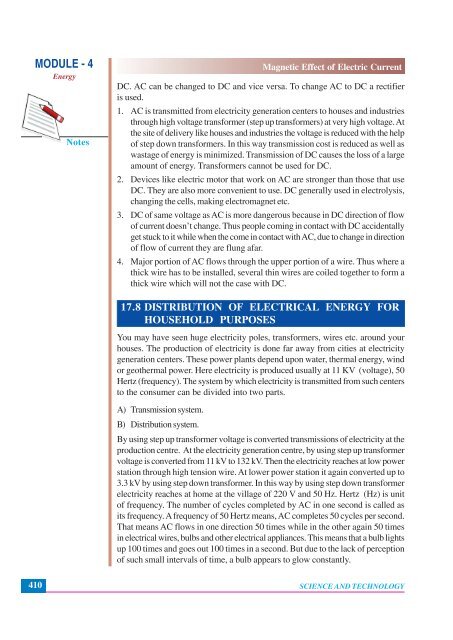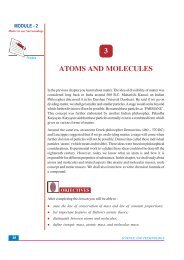17. Magnetic Effect of Electric Current (41.1 MB)
17. Magnetic Effect of Electric Current (41.1 MB)
17. Magnetic Effect of Electric Current (41.1 MB)
You also want an ePaper? Increase the reach of your titles
YUMPU automatically turns print PDFs into web optimized ePapers that Google loves.
MODULE - 4<br />
Energy<br />
Notes<br />
<strong>Magnetic</strong> <strong>Effect</strong> <strong>of</strong> <strong>Electric</strong> <strong>Current</strong><br />
DC. AC can be changed to DC and vice versa. To change AC to DC a rectifier<br />
is used.<br />
1. AC is transmitted from electricity generation centers to houses and industries<br />
through high voltage transformer (step up transformers) at very high voltage. At<br />
the site <strong>of</strong> delivery like houses and industries the voltage is reduced with the help<br />
<strong>of</strong> step down transformers. In this way transmission cost is reduced as well as<br />
wastage <strong>of</strong> energy is minimized. Transmission <strong>of</strong> DC causes the loss <strong>of</strong> a large<br />
amount <strong>of</strong> energy. Transformers cannot be used for DC.<br />
2. Devices like electric motor that work on AC are stronger than those that use<br />
DC. They are also more convenient to use. DC generally used in electrolysis,<br />
changing the cells, making electromagnet etc.<br />
3. DC <strong>of</strong> same voltage as AC is more dangerous because in DC direction <strong>of</strong> flow<br />
<strong>of</strong> current doesn’t change. Thus people coming in contact with DC accidentally<br />
get stuck to it while when the come in contact with AC, due to change in direction<br />
<strong>of</strong> flow <strong>of</strong> current they are flung afar.<br />
4. Major portion <strong>of</strong> AC flows through the upper portion <strong>of</strong> a wire. Thus where a<br />
thick wire has to be installed, several thin wires are coiled together to form a<br />
thick wire which will not the case with DC.<br />
<strong>17.</strong>8 DISTRIBUTION OF ELECTRICAL ENERGY FOR<br />
HOUSEHOLD PURPOSES<br />
You may have seen huge electricity poles, transformers, wires etc. around your<br />
houses. The production <strong>of</strong> electricity is done far away from cities at electricity<br />
generation centers. These power plants depend upon water, thermal energy, wind<br />
or geothermal power. Here electricity is produced usually at 11 KV (voltage), 50<br />
Hertz (frequency). The system by which electricity is transmitted from such centers<br />
to the consumer can be divided into two parts.<br />
A) Transmission system.<br />
B) Distribution system.<br />
By using step up transformer voltage is converted transmissions <strong>of</strong> electricity at the<br />
production centre. At the electricity generation centre, by using step up transformer<br />
voltage is converted from 11 kV to 132 kV. Then the electricity reaches at low power<br />
station through high tension wire. At lower power station it again converted up to<br />
3.3 kV by using step down transformer. In this way by using step down transformer<br />
electricity reaches at home at the village <strong>of</strong> 220 V and 50 Hz. Hertz (Hz) is unit<br />
<strong>of</strong> frequency. The number <strong>of</strong> cycles completed by AC in one second is called as<br />
its frequency. A frequency <strong>of</strong> 50 Hertz means, AC completes 50 cycles per second.<br />
That means AC flows in one direction 50 times while in the other again 50 times<br />
in electrical wires, bulbs and other electrical appliances. This means that a bulb lights<br />
up 100 times and goes out 100 times in a second. But due to the lack <strong>of</strong> perception<br />
<strong>of</strong> such small intervals <strong>of</strong> time, a bulb appears to glow constantly.<br />
410<br />
SCIENCE AND TECHNOLOGY
















